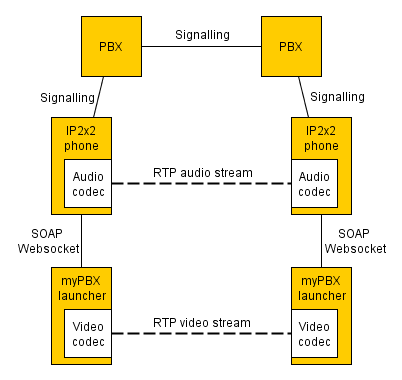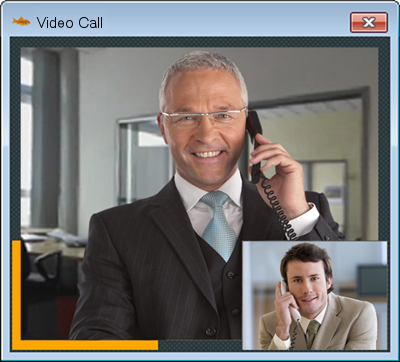Reference10:Concept myPBX Video: Difference between revisions
Jump to navigation
Jump to search
| Line 4: | Line 4: | ||
== How it works == | == How it works == | ||
* myPBX video adds an H.264 video codec to IP2x2 or IP241 phones. | * myPBX video adds an H.264 video codec to IP2x2 or IP241 phones. | ||
* The video codec is part of the myPBX launcher and uses the webcam, windows for H.264 encoding and graphic card of the computer for H.264 decoding. If the graphic does not support H.264, which would be uncommon, windows will be used for decoding. Windows is not used by default because its decoder introduces a long delay (1-2 sec.), unacceptable for a video call. This is supposed to be changed in Windows 8. | * The video codec is part of the myPBX launcher and uses the webcam, windows for H.264 encoding and graphic card of the computer for H.264 decoding. If the graphic does not support H.264, which would be uncommon, windows will be used for the decoding process. Windows is not used by default because its decoder introduces a long delay (1-2 sec.), unacceptable for a video call. This is supposed to be changed in Windows 8. | ||
* The video codec communicates with the phone using SOAP over Websocket. Once it is connected the phone negotiates video calls. | * The video codec communicates with the phone using SOAP over Websocket. Once it is connected the phone negotiates video calls. | ||
* The endpoint for video streams is the video codec on the computer. The endpoint for audio streams is still the audio codec on the phone. | * The endpoint for video streams is the video codec on the computer. The endpoint for audio streams is still the audio codec on the phone. | ||
Revision as of 15:44, 30 October 2012
In version 10 the myPBX launcher can add a video codec to the IP2x2 and IP241 phones.
How it works
- myPBX video adds an H.264 video codec to IP2x2 or IP241 phones.
- The video codec is part of the myPBX launcher and uses the webcam, windows for H.264 encoding and graphic card of the computer for H.264 decoding. If the graphic does not support H.264, which would be uncommon, windows will be used for the decoding process. Windows is not used by default because its decoder introduces a long delay (1-2 sec.), unacceptable for a video call. This is supposed to be changed in Windows 8.
- The video codec communicates with the phone using SOAP over Websocket. Once it is connected the phone negotiates video calls.
- The endpoint for video streams is the video codec on the computer. The endpoint for audio streams is still the audio codec on the phone.
Requirements
PBX
- Recent version 10 firmware
- myPBX license (enabled at the user object)
- Video license (enabled at the user object)
Phone
- IP2x2 or IP241 phone
- Recent version 10 firmware
- Registration with password
Computer
- myPBX launcher version 10
- Windows 7
- .NET 4
- Graphics card with H.264 hardware support
- Webcam
Configuration
In the following, it is assumed that the user already has a phone configured and myPBX running.
PBX
- Enable the video license on the user object.
Launcher
- Nothing special has to be configured. Username, password and the selected phone is taken from the web application.
Usage
Activation
Enable the video checkmark in the context menu of the tray icon. The launcher will then try to register itself on the selected phone as a video codec. It that was successful the tray icon shows a yellow dot indicating that video is active.
Video telephony
When there is a video call, the launcher activates the webcam of the PC and opens a window showing your own image and the image of the remote party. If you hang up the window is closed and the webcam is deactivated.

